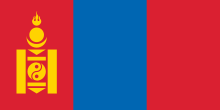Soyombo symbol

The Sojombo symbol is a special character from the Mongolian Sojombo script . It serves as the national symbol of Mongolia , where it can be found on the national coat of arms , on the flag, and on many other official documents.
The elements of the Sojombo symbol have the following meanings in Mongolia (from top to bottom):
- Fire is generally seen as a symbol of wealth and success. The three tongues of the flame stand for past, present and future.
- The sun and moon are ancient symbols of Tengrism for Father Heaven.
- The two triangles indicate the point of an arrow or spear. They both point downwards to indicate the defeat of the internal and external opponents.
- The two horizontal rectangles give the round shape stability. The right-angled shape stands for honesty and justice of the people in Mongolia, regardless of whether they are above or below in society.
- The two fish correspond to the Chinese yin-yang symbol , which represents the complementarity of men and women. Alternatively, under socialism, they were read as symbols of vigilance, as fish never close their eyes.
- The two vertical rectangles can be interpreted as fortress walls and stand for cohesion and strength according to the Mongolian proverb "Two people in friendship are stronger than stone walls".
use
The Soyombo symbol has appeared on the flag of Mongolia since 1911 (except between 1921 and 1924). It served as the coat of arms of Mongolia from 1924 to 1940 and was reintegrated into the design in 1960. It also appears on banknotes, stamps, etc.
The top three elements (flame, sun and moon) can be found on the flag and coat of arms of the Republic of Buryatia and the flag of the Autonomous Okrug of the Agin Buryats in Russia , as well as on the flag of the People's Party of Inner Mongolia .
